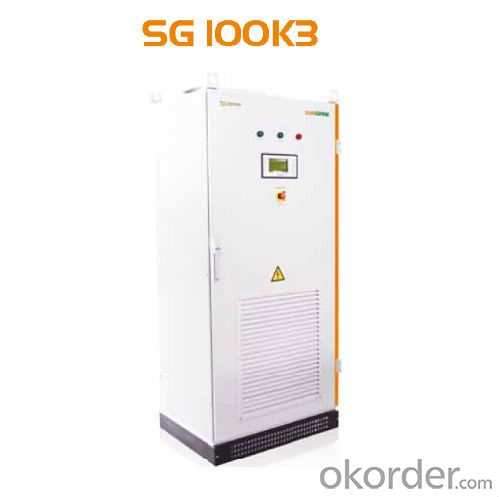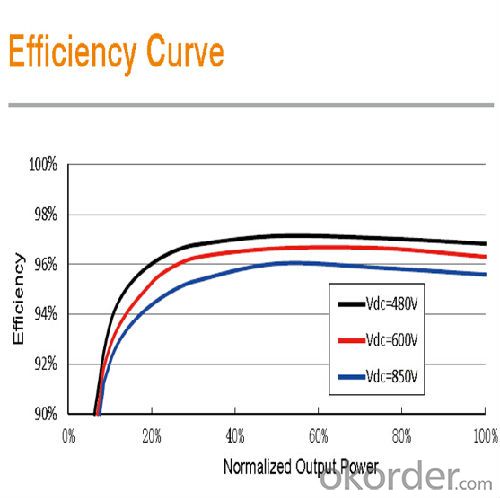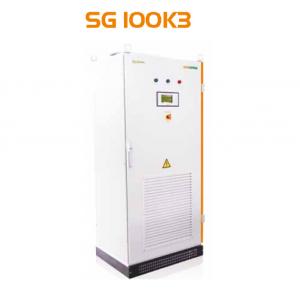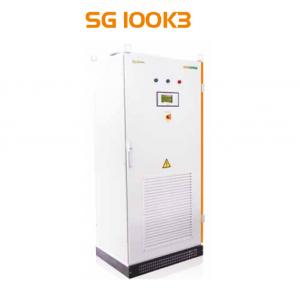Photovoltaic Grid-Connected Inverter SG100K3
- Loading Port:
- China Main Port
- Payment Terms:
- TT or LC
- Min Order Qty:
- 30 unit
- Supply Capability:
- 1000 unit/month
OKorder Service Pledge
OKorder Financial Service
You Might Also Like
1. Structure of Photovoltaic Grid-Connected Inverter SG100K3 Description
A solar inverter, or PV inverter, or Solar converter, converts the variable direct current (DC) output of a photovoltaic (PV) solar panel into
autility frequency alternating current (AC) that can be fed into a commercial electrical grid or used by a local, off-grid electrical network.
It is acritical BOS–component in a photovoltaic system, allowing the use of ordinary AC-powered equipment. Solar inverters have
special functions adapted for use with photovoltaic arrays, including maximum power point tracking and anti-islanding protection.
Suitable for 50Hz/60Hz grid, could be used in Asia, Australia and Europe.
2. Main Features of the Photovoltaic Grid-Connected Inverter SG100K3
* Advanced Technology, Grid-friendly
• Optional low-voltage and zero-voltage ride through to cope with various grid conditions
• SVG function at night, response to grid directives around the clock
• Reactive power control with power factor from 0.9 lagging to 0.9 leading
* More Compact, Saving Space for PV Plant
• Power density enhanced 40%, one of the central inverters with highest power density in the PV industry
• Save installation spaces and lower the plant initial cost
• Front maintenance, able to install against the wall, convenient installation and maintenance, saving operation cost of the PV plant
* Efficient, More Yields
• Max. efficiency at 97.3% with transformer
• Efficient MPPT control strategy, improve power yields
• 28335 chips adopted, more accurate calculation, more power yields
* More Advantages
• Perfect protection and fault alarm system, safe and reliable
• User-friendly dynamic graphics LCD
• Efficient PWM algorithm, low consumption of switch
• Operate without power derating at -25℃ - +55℃
• Reliable and continues operation in high altitude environment
• Auxiliary heater (opt.)
• CGC certification, compliance with BDEW
3. Photovoltaic Grid-Connected Inverter SG100K3 Images



4. Photovoltaic Grid-Connected Inverter SG100K3 Specification
Input Side Data |
|
Max. PV input power | 113KW |
Max. PV input voltage | 1000V |
Set-up voltage | 500V |
Min. operation voltage | 480V |
Max. PV input current | 236A |
MPP voltage range | 480~850V |
No. of DC inputs | 4 |
Output Side Data |
|
Nominal AC output power | 100KW |
Max. AC output apparent power | 110KVA |
Max. AC output current | 158A |
THD | <3%(Nominal power) |
Nominal AC voltage | 400V |
AC voltage range | 310V~450V |
Nominal grid frequency | 50/60Hz |
Grid frequency range | 47~52Hz/57~62Hz |
Power factor | >0.99@default value at nominal power, adj. 0.9 overexcited ~0.9 underexcited |
Isolated transformer | Yes |
DC current injection | <0.5 % In |
Efficiency |
|
Max. efficiency | 97.30% |
European efficiency | 96.70% |
Protection |
|
Input side disconnection device | Breaker |
Output side disconnection device | Breaker |
DC overvoltage protection | Yes |
AC overvoltage protection | Yes |
Grid monitoring | Yes |
Ground fault monitoring | Yes |
Insulation monitoring | Yes |
General Data |
|
Dimensions(W×H×D) | 806×1884×636mm |
Weight | 760kg |
Operating ambient temperature range | -25~+55℃ |
Night power consumption | <40W |
External auxiliary supply voltage | No |
Cooling method | Temperature controlled air-cooling |
Ingress protection rating | IP21 |
Allowable relative humidity range | 0~95% no condensing |
Max. operating altitude | 6000m(>3000m derating) |
Fresh air consumption | 870m³/h |
Display | LCD |
Communication | RS485/Modbus, Ethernet(Opt.) |
5. FAQ of Photovoltaic Grid-Connected Inverter SG100K3
Q1. What is the difference between inverter and solar inverter?
A1. Inverter only has AC inpput, but solar inverter both connect to AC input and solar panel, it saves more power.
Q2. What is the difference between MPPT&PWM?
A2. MPPT has higher efficiency, it can track the max power point and won't waste energy.
- Q:How does a solar inverter synchronize with the grid frequency?
- A solar inverter synchronizes with the grid frequency by constantly monitoring the frequency of the utility grid. It adjusts its own output frequency accordingly to match the grid frequency. This synchronization process ensures that the solar inverter's power output is in phase with the utility grid, allowing it to seamlessly inject solar energy into the grid without any disruptions or compatibility issues.
- Q:How does a solar inverter handle grid voltage variations?
- A solar inverter handles grid voltage variations by continuously monitoring the voltage levels of the grid. When the grid voltage increases or decreases beyond a certain range, the inverter adjusts its output voltage accordingly to maintain a stable and consistent supply of electricity. This ensures that the solar power system remains synchronized with the grid and prevents any damage to the inverter or the connected equipment.
- Q:What is the maximum number of parallel inverters that can be installed in a solar system?
- The maximum number of parallel inverters that can be installed in a solar system depends on various factors such as the size and capacity of the solar system, the availability of space, and the electrical requirements of the installation. There is no fixed maximum number as it can vary significantly depending on these factors.
- Q:How does the size of a solar inverter affect its performance?
- The size of a solar inverter directly impacts its performance. A larger inverter with a higher wattage capacity can handle a greater amount of solar power generated by the panels. On the other hand, a smaller inverter may not be able to efficiently convert and utilize all the energy produced, resulting in a decrease in overall system performance. Therefore, choosing the appropriate size solar inverter is crucial to ensure optimal performance and maximize energy production.
- Q:What are the key features to consider when choosing a solar inverter?
- When choosing a solar inverter, there are several key features to consider. Firstly, the power rating or capacity of the inverter should match the size of your solar panel system to ensure efficient energy conversion. Additionally, the efficiency rating of the inverter is important as it determines how much energy is lost during the conversion process. It is also crucial to look for an inverter with reliable and durable components to ensure long-term performance and minimize maintenance costs. Other important features include the presence of monitoring capabilities, such as data logging and remote monitoring, which allow you to track the performance of your solar system. Finally, considering the warranty and customer support offered by the manufacturer is essential to ensure adequate support and protection for your investment.
- Q:Can a solar inverter be used in systems with different module tilts?
- Yes, a solar inverter can be used in systems with different module tilts. Solar inverters are designed to convert the DC power generated by solar modules into AC power that can be used in electrical systems. They are typically compatible with a wide range of module tilts and orientations. However, it is important to ensure that the inverter is properly configured to match the specific tilt angles of the solar modules for optimal performance and maximum energy generation.
- Q:What is the role of a fault detection system in a solar inverter?
- The role of a fault detection system in a solar inverter is to monitor and identify any issues or malfunctions within the inverter system. It helps to prevent or minimize downtime by quickly detecting faults such as overvoltage, overcurrent, short circuits, or temperature abnormalities. By promptly identifying and alerting the system operator about these faults, the fault detection system allows for timely maintenance or repairs, ensuring optimal performance and safety of the solar inverter.
- Q:PV grid-connected inverter can directly load it?
- Grid-connected inverter is like a car file, he first detects the grid waveform, can not detect not boot, and then the PV DC modulation and consistent with the grid waveform, and then hang up.
- Q:Can a solar inverter be used with energy storage systems?
- Yes, a solar inverter can be used with energy storage systems. In fact, solar inverters are often used in conjunction with energy storage systems to convert the direct current (DC) energy generated by solar panels into alternating current (AC) energy for use in homes or businesses, while also charging and discharging energy from the storage system as needed. This allows for greater flexibility and efficiency in managing and utilizing solar energy.
- Q:How does a solar inverter handle voltage fluctuations from the battery bank?
- A solar inverter handles voltage fluctuations from the battery bank by utilizing its built-in control mechanisms and electronics. These components monitor the voltage output of the battery bank and regulate it to ensure stable and consistent voltage levels. This helps prevent any sudden or drastic fluctuations that could potentially damage electrical equipment or disrupt the functioning of the system.
1. Manufacturer Overview |
|
|---|---|
| Location | |
| Year Established | |
| Annual Output Value | |
| Main Markets | |
| Company Certifications | |
2. Manufacturer Certificates |
|
|---|---|
| a) Certification Name | |
| Range | |
| Reference | |
| Validity Period | |
3. Manufacturer Capability |
|
|---|---|
| a)Trade Capacity | |
| Nearest Port | |
| Export Percentage | |
| No.of Employees in Trade Department | |
| Language Spoken: | |
| b)Factory Information | |
| Factory Size: | |
| No. of Production Lines | |
| Contract Manufacturing | |
| Product Price Range | |
Send your message to us
Photovoltaic Grid-Connected Inverter SG100K3
- Loading Port:
- China Main Port
- Payment Terms:
- TT or LC
- Min Order Qty:
- 30 unit
- Supply Capability:
- 1000 unit/month
OKorder Service Pledge
OKorder Financial Service
Similar products
New products
Hot products
Related keywords






























